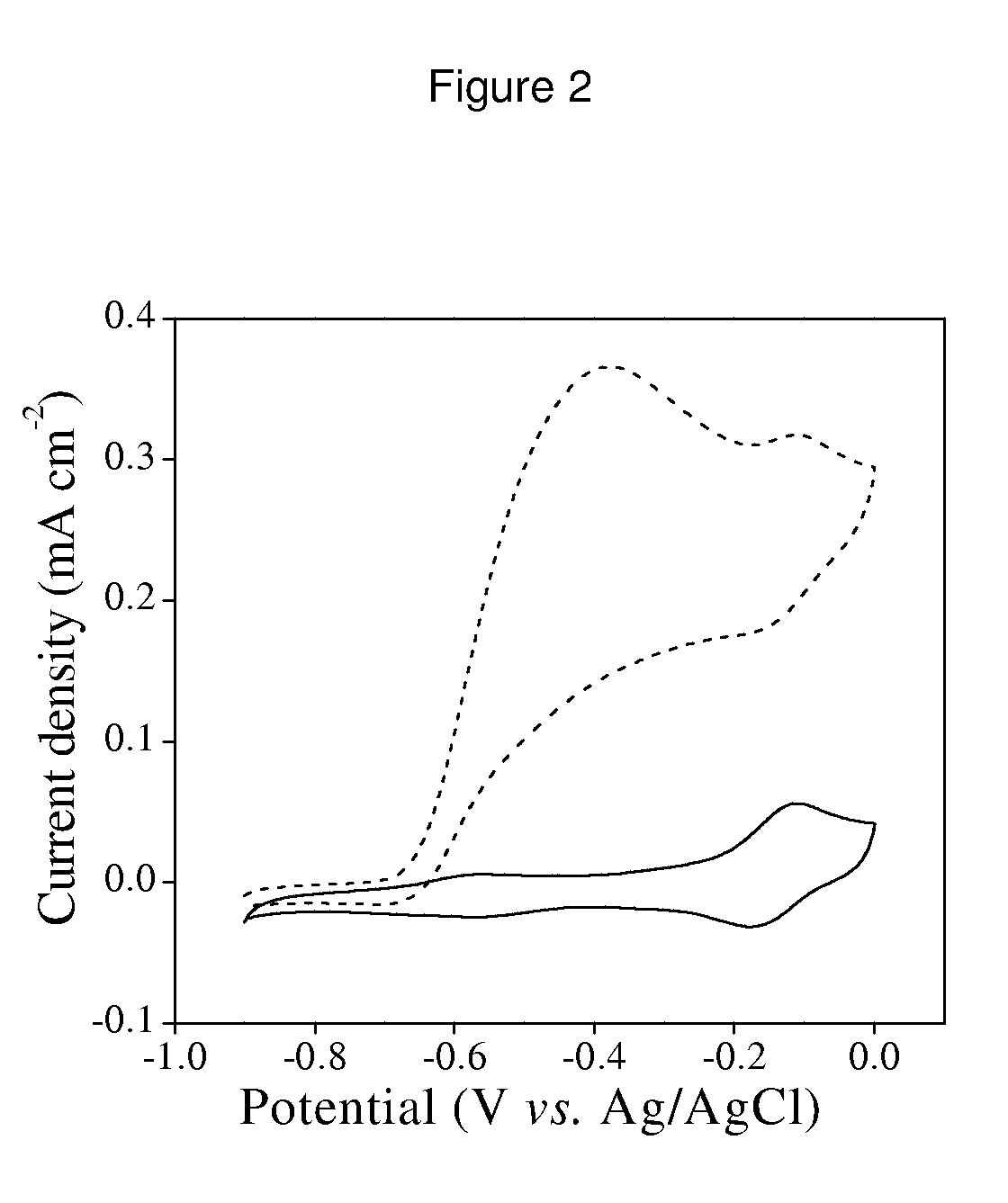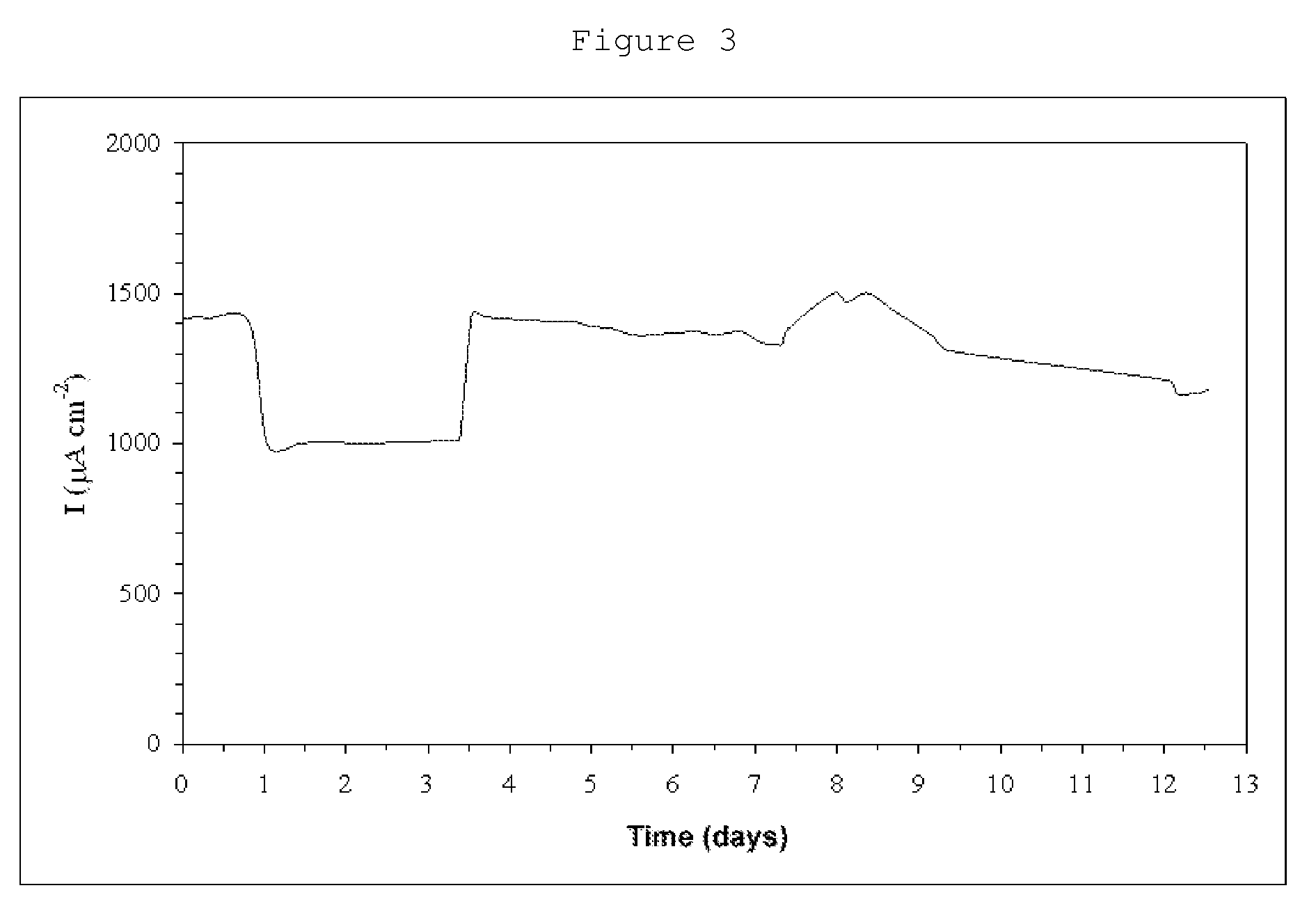Biological electrode with the hydrogenase enzyme, method of obtaining same and applications thereof
a technology of hydrogenase enzyme and biological electrode, which is applied in the field of biological electrodes for hydrogen fuel cells, can solve the problem that none of these patents or publications considers the oriented immobilisation of redox enzymes for direct electron transfer
- Summary
- Abstract
- Description
- Claims
- Application Information
AI Technical Summary
Benefits of technology
Problems solved by technology
Method used
Image
Examples
example 1
Biological Electrode on Gold Metallic Electrode
[0063]A particular embodiment of this invention is the biological electrode of the invention wherein the hydrogenase-type enzyme is isolated from the Desulfovibrio gigas E.C.1.18.89.1 bacteria (a sequence of the enzyme used or reference in the Protein Data Bank has the code PDB 1H2A) and the electrode is polycrystalline gold in the form of thread, polished and washed as described in Fernández V. M. et al. (Journal of the American Chemical Society, 119, 1043-1051, 1997), which is sonicated in ethanol for 15 minutes. Subsequently, it is incubated in 1 mM cysteamine in 2:1 ethanol:water for 20 hours. Following washing with 10 mM Hepes buffer, pH 7.6, it is submerged in a 0.8 micromolar solution of hydrogenase from D. gigas containing N-(3-dimethylaminopropyl)-N′-ethylcarbodiimide hydrochloride hydrate and 10 mM N-hydroxysuccinimide in Hepes buffer, pH 7.6, for 90 min at 25° C.
[0064]Subsequently, it is placed in a typical three-electrode el...
example 2
Biological Electrode in a Pyrolytic Carbon Electrode
[0067]In the preparation of functional hydrogenase electrodes, the use of electrodes made of carbonaceous materials, such as glassy carbon or pyrolytic carbon, has been researched. These electrodes, conveniently modified by means of chemical treatments, have allowed for lasting covalent binding of the hydrogenase molecules isolated from the Desulfovibrio gigas bacteria, purified according to the method described by E. C. Hatchikian et al. (Characterization of the periplasmic hydrogenase from Desulfovibrio gigas. E. C. Hatchikian, M. Brushi and J. IeGall, Biochemical and Biophysical Research Communications 82, 451-461 (1978)).
[0068]In this example, a superficial layer of primary amines is created on pyrolytic carbon electrodes obtained from Pine Instruments, Inc. (USA), by electrochemical reduction of diazonium salts. In the example described, an “edge” pyrolytic carbon electrode (previously modified with the reagent tetrafluorobora...
example 3
Biological Electrode in a Carbon Nanotube Electrode
[0073]Hydrogenase from D. gigas was covalently bound to a carbon nanotube electrode, with a geometric surface area of 0.017 cm2, in the same manner as in Example 2. In this case, the current densities measured are higher due to the electrode's greater roughness. The stability was measured continuously, at a fixed potential of −520 mV, against a calomel electrode, with an electrode rotation of 2,500 rpm, under a hydrogen current and at a temperature of 40° C., it being observed that, following two continuous weeks, 80% of the initial activity was maintained.
[0074]The rational basis for the method of immobilising the Fe—Ni hydrogenase, which is an object of this invention and whereof the enzyme from Desulfovibrio gigas may be considered a typical structure, is the presence of a strong dipolar moment in said enzyme's molecule as a consequence of an asymmetric distribution of charged amino acid residues on the surface of the enzyme. In ...
PUM
| Property | Measurement | Unit |
|---|---|---|
| pH | aaaaa | aaaaa |
| pH | aaaaa | aaaaa |
| ionic strength | aaaaa | aaaaa |
Abstract
Description
Claims
Application Information
 Login to View More
Login to View More - R&D
- Intellectual Property
- Life Sciences
- Materials
- Tech Scout
- Unparalleled Data Quality
- Higher Quality Content
- 60% Fewer Hallucinations
Browse by: Latest US Patents, China's latest patents, Technical Efficacy Thesaurus, Application Domain, Technology Topic, Popular Technical Reports.
© 2025 PatSnap. All rights reserved.Legal|Privacy policy|Modern Slavery Act Transparency Statement|Sitemap|About US| Contact US: help@patsnap.com



